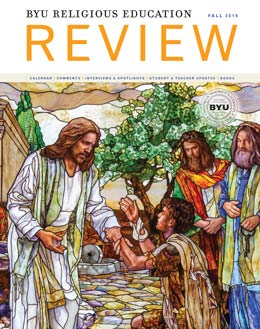BYU Graduate Chaplain Program, Master of Arts Chaplaincy
Allen Blake Boatright
Allen Blake Boatright (blake_boatright@byu.edu) was an associate graduate coordinator for the masters in chaplaincy program in BYU Religious Education when this was published. He began teaching at BYU in 2012 after retiring from a thirty-four-year career in the U.S. Army, where he was enlisted and an infantry officer and a chaplain endorsed by The Church of Jesus Christ of Latter-day Saints.
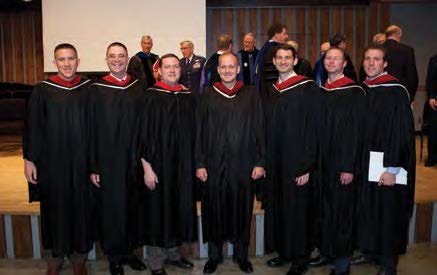 Chaplain graduates, left to right: Ryan Williams, Rick Gabbitas, Chad Thompson, Jacob Snell, James Willis, Loren Omer, Mark Simonsen.
Chaplain graduates, left to right: Ryan Williams, Rick Gabbitas, Chad Thompson, Jacob Snell, James Willis, Loren Omer, Mark Simonsen.
Throughout the world, chaplains provide ministry in pluralistic settings, ministering to everyone in their stewardship, regardless of their faith or nonfaith. They nurture the living, provide ministry to the wounded, and honor the dead. Brigham Young University’s master of arts chaplaincy program provides the military the most qualified candidates in an ever-changing military environment, in times of peace and in war. Brigham Young University’s motto is “Enter to Learn; Go Forth to Serve.” Brigham Young University’s master of arts chaplaincy motto, “Ministry—Anytime and Anyplace,” complements BYU’s motto.
How did BYU’s current program come to be? In 2008 BYU Religious Education hired Dr. Roger R. Keller to begin a graduate military chaplain program. A cohort of ten students began this two-year course of study in preparation for application to become Latter-day Saint chaplains. Two years later another cohort of twelve began the same process. All but three are currently serving throughout the world in the Reserves or Active Duty.
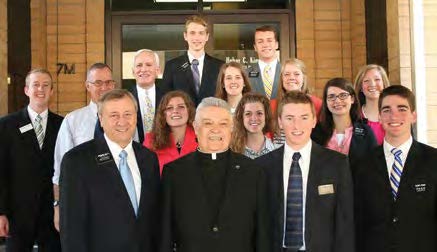 Father Michael Ortiz, Special Forces chaplain serving in Vietnam, was the 2014 interfaith lecture speaker and is shown visiting the Provo Utah Missionary Training Center. Courtesy of Blake Boatright.
Father Michael Ortiz, Special Forces chaplain serving in Vietnam, was the 2014 interfaith lecture speaker and is shown visiting the Provo Utah Missionary Training Center. Courtesy of Blake Boatright.
In 2012 Dr. Keller retired, and two retired Army chaplains, Allen Blake Boatright and Vance P. Theodore, were hired to run and revise the chaplain program. Boatright and Theodore are continually revising and revamping the graduate program to meet the professional and educational standards of an Armed Forces chaplain. It became a program with ninety graduate hours to be completed in twenty-two months of full-time study instead of eighty-four hours. It includes coursework in graduate religious education and courses offered through social work, counseling psychology, marriage, and family therapy, and social work. In addition to the classroom work, the students complete four hundred hours of Clinical Pastoral Education (CPE), which is hospital ministry. The CPE work is one hundred hours of classroom time in small groups and three hundred hours of clinical internship as hospital chaplains. Several local hospitals have participated in the CPE work with qualified supervisors. Candidates are also required to complete a substantial project that has a practical application for chaplains that are serving in the armed forces. The program concludes with oral exams in their chaplaincy emphasis that consists of twenty-four graduate hours.
With forty-nine years of experience between them, Boatright and Theodore have made significant changes to the program. For example, they borrowed a world religions class from the National Defense University, Washington, DC, titled World Religions and Security Analysis/
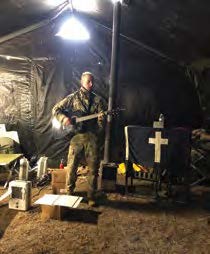 Chaplain (CPT) Garrett Cardinet providing religious services in the field. Courtesy of Garrett Cardinet, MA Chaplaincy, BYU class of 2017.
Chaplain (CPT) Garrett Cardinet providing religious services in the field. Courtesy of Garrett Cardinet, MA Chaplaincy, BYU class of 2017.
Boatright and Theodore developed coursework in ethics, professional roles, and standards of Latter-day Saint chaplains in the Armed Forces. Yearly, Religious Education sponsors an interfaith lecture series, where prominent individuals from different faith-based traditions address faculty and graduate students about their religious beliefs.
Another change Boatright and Theodore made was to add pastoral counseling and chaplain care ministry to counseling scenarios that are tailored to the common challenges chaplains encounter in the Armed Forces. Boatright and Theodore also felt inspired to engage drama students as “counselees,” who learn a script outline from actual cases and then act as if they are going to a chaplain for assistance.
In 2014 The Church of Jesus Christ of Latter-day Saints with the Endorser, Frank Clawson, decided to endorse all chaplains who are members of the Church. The title of the Endorser’s office, Military Relations, changed to Military Relations and Chaplain Services. This brought Healthcare Chaplains, Fire and Police Chaplains, and the US Border Patrol Agents/
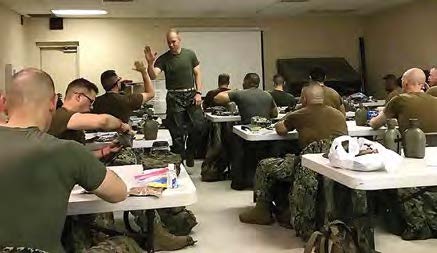 Chaplain (CPT) James Hummel teaching resiliency classes to Marines. Courtesy of James Hummell, MA Chaplaincy, BYU class of 2017.
Chaplain (CPT) James Hummel teaching resiliency classes to Marines. Courtesy of James Hummell, MA Chaplaincy, BYU class of 2017.
In 2017 Delacie Barney, the first Latter-day Saint Healthcare Chaplain student at BYU, was admitted in a pilot program to see what resources and curriculum would be needed to develop a Healthcare Chaplain program as part of the BYU Chaplain program. She graduated in June 2019. Her graduate project is titled “BYU Master of Arts—Chaplaincy Program Curriculum Analysis from a Healthcare Chaplaincy Perspective.” The purpose of the analysis is to determine the feasibility of supporting graduate Latter-day Saint healthcare education in the future. Interestingly her committee members included the dean of the Religious Education, Dr. Daniel K Judd, and the dean of the School of Nursing, Dr. Patricia Ravert, with Blake Boatright as chair. Delacie Barney defended her project and gave the dean of Religious Education a valuable tool to bring about change at BYU in healthcare chaplaincy graduate education.
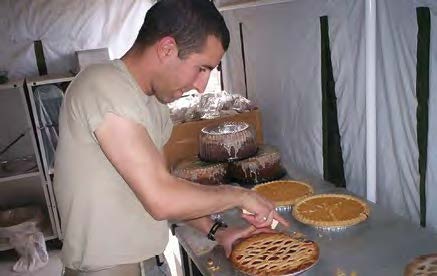 Chaplain (CPT) Marc Deluca serving pies for Thanksgiving in Iraq. Courtesy of Marc Deluca, MA Chaplaincy, BYU class of 2014.
Chaplain (CPT) Marc Deluca serving pies for Thanksgiving in Iraq. Courtesy of Marc Deluca, MA Chaplaincy, BYU class of 2014.
Latter-day Saint female chaplains have been serving for some time. Before Delacie Barney was our first female chaplain student at BYU, Tami Fitzgerald Harris was the first Latter-day Saint female to become a chaplain and has been a chaplain for over thirty years. She writes, “Chaplain training was not available for me when I was a student at BYU, but neither was a laptop, a whiteboard, or caller ID. Times have changed. With those changes there is growth, opportunities, and inspiration in how to move the work of the Lord forward. Having women in chaplaincy in the Church is an exceptional fit. They have innate talents and gifts, including the ability to help others feel safe. In a world increasingly filled with turmoil, the need for trained, Latter-day Saint women chaplains will only increase. I’m thrilled the door is open for women [and men] to be accepted into the BYU chaplaincy program. The need is great, and the timing is perfect.”
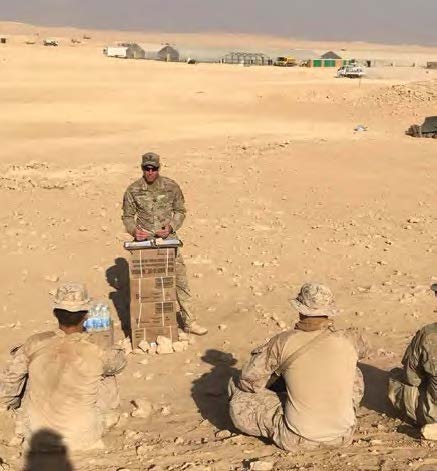 Chaplain (CPT) Bryce Wiltermood conducting religious services in Syria. Courtesy of Bryce Wiltermood, MA Chaplaincy, BYU class of 2015.
Chaplain (CPT) Bryce Wiltermood conducting religious services in Syria. Courtesy of Bryce Wiltermood, MA Chaplaincy, BYU class of 2015.
The chaplains selected for duty in the Armed Forces and in other settings bless the lives of men, women, and families throughout the world. They are a small group of professionals working to bring powerful ministry to places that are not the normal venue for ministry or worship.
Sidebar: For those who are interested in becoming a chaplain in the MA chaplaincy program, there are two parts to the application process. First, an applicant must contact the endorser’s office for The Church of Jesus Christ of Latter-day Saints at 801-240-2286. The staff in that office will guide an applicant through the screening process that includes a psychological test (to assess mental health) and culminates in an interview with a General Authority Seventy over the military relations and chaplain services of the Church. Second, the applicant is directed to the BYU graduate studies application process. Then the applicant will have an interview, usually after 1 December for the upcoming year. The applicants are selected competitively to begin the following summer term at BYU. Of the eleven applicants last year, six were selected as best qualified, two became alternates and three received a suggestion to look elsewhere for a career. So far, those selected will receive a full-tuition scholarship and a small stipend. These candidates bless the lives of all those they come into contact with and continue to be the best possible ambassadors for The Church of Jesus Christ of Latter-day Saints.
